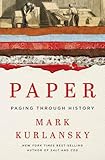Paper : paging through history / Mark Kurlansky.
Material type: TextPublisher: New York : W.W. Norton & Company, [2016]Edition: First editionDescription: xx, 389 pages : illustrations ; 25 cmContent type: text | still image Media type: unmediated Carrier type: volumeISBN: 9780393239614 (hardcover); 0393239616 (hardcover); 9780393353709 (paperback); 0393353702 (paperback)Subject(s): Papermaking -- History | Paper industry -- History | 20160531 NEW LIST | HISTORY -- World | Paper industry | PapermakingGenre/Form: History.DDC classification: 676.09 LOC classification: TS1090 | .K87 2016Other classification: HIS037000 | TEC056000 | SOC052000
TextPublisher: New York : W.W. Norton & Company, [2016]Edition: First editionDescription: xx, 389 pages : illustrations ; 25 cmContent type: text | still image Media type: unmediated Carrier type: volumeISBN: 9780393239614 (hardcover); 0393239616 (hardcover); 9780393353709 (paperback); 0393353702 (paperback)Subject(s): Papermaking -- History | Paper industry -- History | 20160531 NEW LIST | HISTORY -- World | Paper industry | PapermakingGenre/Form: History.DDC classification: 676.09 LOC classification: TS1090 | .K87 2016Other classification: HIS037000 | TEC056000 | SOC052000 | Item type | Current library | Call number | Copy number | Status | Notes | Date due | Barcode |
|---|---|---|---|---|---|---|---|
 Books
Books
|
Female Library | TS1090 .K87 2016 (Browse shelf (Opens below)) | 1 | Available | STACKS | 51952000327448 | |
 Books
Books
|
Main Library | TS1090 .K87 2016 (Browse shelf (Opens below)) | 1 | Available | STACKS | 51952000327455 |
Browsing Female Library shelves Close shelf browser

|

|

|

|

|

|

|
||
| TR897.7 .K469 2009 The essential guide to Flash CS4 / | TR897.7 .M425 2007 Maya 8 : the complete reference / | TR897.7 .P464 2004 Extending Macromedia Flash MX 2004 : complete guide and reference to JavaScript Flash / | TS1090 .K87 2016 Paper : paging through history / | TS1445 .C64 2010 J.J. Pizzuto's Fabric science / | TS1446 .K33 2009 Textiles / | TS155 .C13 2009 Matching supply with demand : an introduction to operations management / |
Includes bibliographical references (pages 347-354) and index.
Prologue: The technological fallacy -- Being human -- The moths that circle a Chinese candle -- The Islamic birth of literacy -- And where is Xátiva? -- Europe between two felts -- Making words soar -- The art of printing -- Out from Mainz -- Tenochtitlán and the blue-eyed devil -- The trumpet call -- Rembrandt's discovery -- The traitorous corruption of England -- Papering independence -- Diderot's promise -- Invitation from a wasp -- Advantages in the head -- To die like gentlemen -- Return to Asia -- Epilogue: change -- Appendix: Timeline.
Through tracing paper's evolution, Mark Kurlansky challenges common assumptions about technology's influence, affirming that paper is here to stay.
Paper is one of the simplest and most essential pieces of human technology. For the past two millennia, the ability to produce it in ever more efficient ways has supported the proliferation of literacy, media, religion, education, commerce, and art; it has formed the foundation of civilizations, promoting revolutions and restoring stability. One has only to look at history's greatest press run, which produced 6.5 billion copies of Quotations from Chairman Mao (which doesn't include editions in 37 foreign languages and in braille) to appreciate the range and influence of a single publication, in paper. Or take the fact that one of history's most revered artists, Leonardo da Vinci, left behind only 15 paintings but 4,000 works on paper. And though the colonies were at the time calling for a boycott of all British goods, the one exception they made speaks to the essentiality of the material; they penned the Declaration of Independence on British paper. Now, amid discussion of "going paperless"--And as speculation about the effects of a digitally dependent society grows rampant--we've come to a world-historic juncture. Thousands of years ago, Socrates and Plato warned that written language would be the end of "true knowledge," replacing the need to exercise memory and think through complex questions. Similar arguments were made about the switch from handwritten to printed books, and today about the role of computer technology. By tracing paper's evolution from antiquity to the present, with an emphasis on the contributions made in Asia and the Middle East, Mark Kurlansky challenges common assumptions about technology's influence, affirming that paper is here to stay.--Adapted from dust jacket.
1 2

There are no comments on this title.